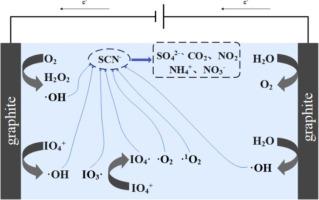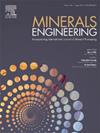利用石墨电极对高碘酸盐进行电化学活化,以降解选矿尾液中的高浓度硫氰酸根 (SCN-)
IF 4.9
2区 工程技术
Q1 ENGINEERING, CHEMICAL
引用次数: 0
摘要
氰化物因其成本效益高、选择性强和回收率高而被广泛用于黄金提取。遗憾的是,氰化物的广泛应用也导致选矿厂尾液中存在大量硫氰原(SCN-),影响出水水质,从而对生态环境和人类健康构成威胁。本文利用电化学氧化/过硫酸盐(E-GP/PI)系统研究了水中高浓度 SCN- 的降解问题。通过优化各种操作参数,SCN- 的降解率达到了 90.25%。研究了有机物和典型重金属离子浓度对 SCN- 降解的影响,发现 Cu2+ 能够通过与 SCN- 形成稳定的络合物促进 SCN- 的降解,从而将降解率提高到 96.48%。然而,十八烷基三甲基溴化铵(OTAB)和丁基黄质的存在阻碍了降解过程,其中 500 mg/L 的 OTAB 可将 SCN- 的降解率降至 80.88 %,而 100 mg/L 的丁基黄质可将降解率降至 78.66 %。在此基础上,利用实际废水样品进行了实验,结果表明 SCN- 的降解效率约为 90%。随后,通过电子顺磁共振分析、自由基猝灭、离子色谱等研究技术,得出了 IO3 和 O2- 是 SCN- 降解的主要驱动因子,并阐明了 SCN- 降解途径。最后,在水蚤毒性试验中,E-GP/PI 系统能有效降低 SCN- 的生态毒性,其 24 小时半数致死浓度从 12.5% 提高到 48.5%。这项研究为绿色高效处理富含 SCN- 的选矿尾液提供了新思路。本文章由计算机程序翻译,如有差异,请以英文原文为准。

Electrochemical activation of periodate with graphite electrodes for degradation of high concentrations of thiocyanogen (SCN−) in mineral processing tail liquid
Cyanide has been widely used in gold extraction due to its cost-effectiveness, high selectivity and recovery. Regrettably, its wide application also leads to the presence of a large amount of thiocyanogen (SCN−) in the tail liquid of mineral processing plants, which affects the quality of the effluent water, and thus poses a threat to the ecological environment and human health. This paper investigates the degradation of high concentration of SCN− in water using electrochemical oxidation/periodate (E-GP/PI) system. A degradation rate of 90.25 % of SCN− was achieved by optimising various operating parameters. The effects of organic matter and typical heavy metal ion concentrations on the degradation of SCN− were investigated, and it was found that Cu2+ was able to promote the degradation of SCN− through the formation of stable complexes with SCN−, which enhanced the degradation rate to 96.48 %. However, the presence of Octadecyltrimethylammonium bromide (OTAB) and butylxanthin hindered the degradation process, where 500 mg/L of OTAB reduced the degradation rate of SCN− to 80.88 %, while 100 mg/L of butylxanthin reduced the degradation rate to 78.66 %. On this basis, experiments were carried out using real wastewater samples and SCN− degradation efficiencies of about 90 % were obtained. Afterwards, through electron paramagnetic resonance analysis, free radical burst, ion chromatograph and other research techniques, IO3![]() and
and ![]() O2– were obtained as the main drivers of SCN− degradation and SCN− degradation pathways were elucidated. Finally, the E-GP/PI system was shown to be effective in reducing the ecotoxicity of SCN− by increasing the 24-h LC50 from 12.5 % to 48.5 % in a toxicity test with daphnia. This study provides a new idea for the green and efficient treatment of SCN− rich beneficiation tail liquid.
O2– were obtained as the main drivers of SCN− degradation and SCN− degradation pathways were elucidated. Finally, the E-GP/PI system was shown to be effective in reducing the ecotoxicity of SCN− by increasing the 24-h LC50 from 12.5 % to 48.5 % in a toxicity test with daphnia. This study provides a new idea for the green and efficient treatment of SCN− rich beneficiation tail liquid.
求助全文
通过发布文献求助,成功后即可免费获取论文全文。
去求助
来源期刊

Minerals Engineering
工程技术-工程:化工
CiteScore
8.70
自引率
18.80%
发文量
519
审稿时长
81 days
期刊介绍:
The purpose of the journal is to provide for the rapid publication of topical papers featuring the latest developments in the allied fields of mineral processing and extractive metallurgy. Its wide ranging coverage of research and practical (operating) topics includes physical separation methods, such as comminution, flotation concentration and dewatering, chemical methods such as bio-, hydro-, and electro-metallurgy, analytical techniques, process control, simulation and instrumentation, and mineralogical aspects of processing. Environmental issues, particularly those pertaining to sustainable development, will also be strongly covered.
 求助内容:
求助内容: 应助结果提醒方式:
应助结果提醒方式:


